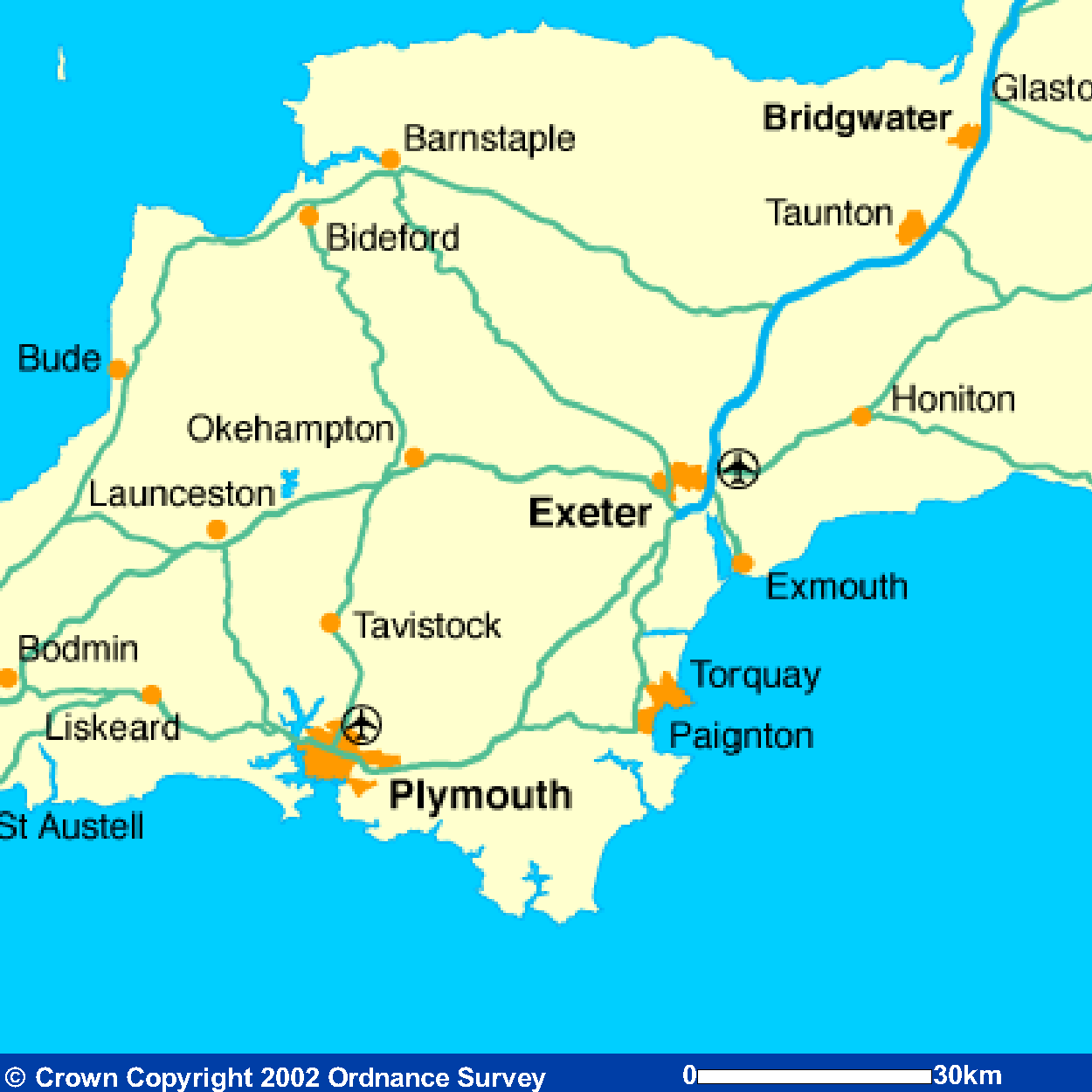
Image produced from the Ordnance Survey Get-a-map service and
reproduced with kind permission of Ordnance Survey.
Part One
Introduction
In October 1978, my wife Shirley and I took a motoring holiday to the English 'West Country' and on the way stopped at the Devon market town of Honiton - to buy something for a picnic lunch. I didn't realise it then but that short stop proved to be the first step in what turned out to be an abiding interest in genealogy. We walked along a pleasant street of shops (called New Street) looking for a bakery - where we purchased sausage rolls and a Cornish pastie. On the way, we passed a shop selling 'Honiton lace', which I recalled was once a specialty of this area, and this in turn, for some reason, also brought to mind vague memories from my childhood in Vancouver about my grandfather Joseph Millman. I knew he was born in Exeter in Devon and later lived in Bristol, before emigrating to Canada - where I grew up. But I couldn't recall how or why Honiton may have entered the picture. Possibly I had been told that his people had emanated from there? We passed a Post Office, so I checked the local telephone book (which included Exeter) to see if there were any Millmans in the area; in most locations, it wasn't a very common name. I was amazed to see almost two columns of them!

Image produced from the Ordnance Survey Get-a-map service and
reproduced with kind permission of Ordnance Survey.
The reflections on my grandfather took my mind back to other half forgotten stories from my youth, including that concerning the tragic theatre fire in Exeter in which his father had perished. As a result, young Joseph was sent to a school somewhere in London. I was told that his father had been a woodcarver or stonemason who had worked on Exeter cathedral. He was also supposed to have saved some people in the fire before succumbing himself. We had our picnic and as we drove on towards Exeter, I began wondering if any of the local newspapers may have an archive in which I might learn more about the fire and some account of his role in this major disaster. Shirley suggested we try the Exeter library first. They referred us to the Devon Record Office next door and they in turn to the Local History section. We explained our interest and in a few minutes, an assistant returned with a box full of old newspaper clippings, photos, letters, etc as well as a large ledger-type book - all concerning the fire. We sat down and began looking at everything. It had a most profound effect on me.
There was so much to look at, so many bits and pieces, that one didn't know where to start. With both of us looking at different things and drawing each other's attention to this and that, our senses were bombarded with impressions. It was at once obvious that it had been a horrendous tragedy - with many people killed and countless others badly injured. The old browned photos showed the burnt-out shell of the theatre and as I was examining them, I suddenly realised for the first time that the vague, brief references to all this that I'd heard as a child was something that had really happened - to real people - and that one of them was my great grandfather. He was also a Joseph, then still quite young (at 28) with a wife Jane and two young children: Harriett, 8 and young Joseph, only 5. I turned to Shirley in silence - with tears welling in my eyes. I think it was being confronted with so much within just a few moments and realising how unimaginative I had been about it previously.
We next opened the large book in which were recorded the veratim accounts of those who came to identify the dead. This too was a moving experience as I read the following:
"William Millman on his Oath: 'I am a Painter and live at 2 Gibbs Place, Coombe Street, Exeter
and identify the body lying dead and numbered 1 in the London Hotel stables as that of my brother
Joseph Millman. He was a Fish Hawker - 28 years of age - and resided at 50 Coombe Street,
Exeter. He was married. He went alone to the Theatre last night and sat in the Gallery.' William Millman".
There were pages and pages of such entries. 188 people died in all - still the largest number ever to perish in a fire in the U.K.
I thereby learned that my great grandfather was named Joseph, that he had a brother William who was a (House) Painter and that Joseph was not then at least a carver or mason but a seller of fish and, importantly, where he lived. There was no mention of any individual acts of bravery save one regarding a sailor. There were no doubt many brave efforts - too many to point out. Most of the dead had sat in the top Gallery, as had Joseph. A London illustrated periodical of the day (The Graphic, Sept 10, 1887 - pp 293-4) gave an excellent account. The theatre, called The New Theatre Royal, caught fire on Monday evening, September 5th, 1887 on the first night of a new play called 'The Romany Rye' acted by 'Mr Elliot's Specially Selected Company'. Thankfully, Joseph had gone alone, leaving Jane at home with their children. They weren't that well off and, like many, he may have gone in after some intermission on a reduced tariff - especially to the Gallery. The exact cause of the fire was never established. But an inquest concluded that there were insufficient fire exits.
A fund was soon set up for the families of the victims. Money was sent in from all the country, especially from those in the acting profession. Sir Henry Irving sent in £500 (or 5 years wages for most and so today worth an amazing £100,000). The fund was administered by the City of Exeter and grants were given to widows at intervals. We noted that Joseph's widow Jane (see photo below) received 3 shillings and 6 pence on one occasion. Also, the 80-odd children who had lost one or both parents and had insufficient support from relatives (apparently the majority) were sent away to be educated in London.
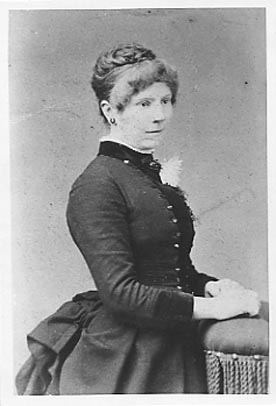
An account of this was given in another magazine called 'Charity' in December 1887. We copied 2 pages of this, one of which shows a picture of 18 of the younger orphans who were sent to the junior branch of the school concerned. When I first saw this picture, I immediately spotted 3 children I recognised as my grandfather Joseph!
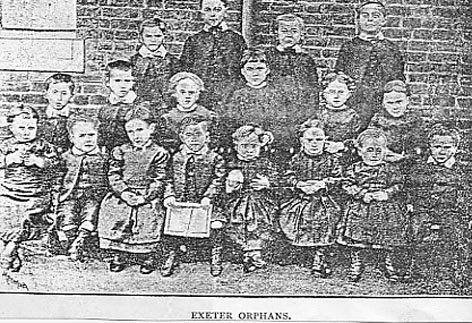
My present view is that he is likely the one in the front row holding the open book, with his sister Harriet seated directly behind him. These children all went to the Alexander Orphanage, the junior branch of the Orphans Working School. Both were situated in north London some miles apart at Hornsey Rise and Haverstock Hill, respectively. A picture of a dormitory at the junior school was shown in the Charity article. It is reproduced below - beside an early photo of Joseph and Harriet taken about a year before their father died:
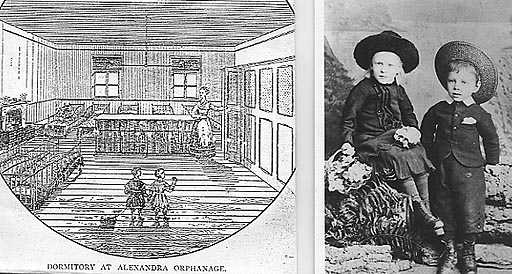
I can imagine them exchanging stories about their Dad with their little friends here - every father a hero, not to be outdone by the others. Who would presume to validate them now - one way or the other?
Joseph's slightly older sister transferred to the Senior school at 10 or 11, in about 1889, but was reported to have soon returned home to her mother as she was said to be sickly. Possibly her mother just wanted her home, as she survived well into adulthood. Joseph transferred to the Senior school in 1892. Every year an Inspector was sent from Exeter to report on how the children in London were doing. Many of these reports were filed in another book, along with countless letters from those who had subscribed to the disaster fund. The reports on the Schools were mostly of a general nature but eventually we spotted two Report Cards on Joseph himself:

Now, his academic record doesn't look too exciting but it was elsewhere pointed out that the school had many middle class children from London while the level of education and social status of those from Exeter was generally poorer. (Thus, neither Joseph's father or uncle could sign there own names, except with a cross; this fate may well have befallen young Joseph too, had the tragedy of the fire not so altered the future for him - and his progeny.) However, the second Report suggests some progress and finally, just before leaving at Christmas 1896 (at age 14), the Inspector's report stated: "There are 3 children who attain the limit of age this year...The oldest, Joseph Millman, was spoken very highly of by the Master, who had no doubts that if an application were made, he would be permitted to remain at the school until midsummer 1897. The boy himself is very anxious to get into an office. The Master said that he had no doubt that he should be able to secure a position for him in one of the large London establishments...". This comment I find very poignant in view of later conclusions about the unrealised potential of the previous five generations of Joseph's forebears (see part Two). "...spoken very highly of by the Master..." rings in my ears whenever I think of this.
Alas, Joseph's dream was not to be... His mother had arranged an apprenticeship for him - with a Confectioner (Fancy Baker) named Farley in the town she had apparently moved to with her new husband - a Mr Board. The town? It was Honiton! No doubt, this was why I had heard the name mentioned in my youth. It wasn't to be the place of origin of the Millmans after all. I had also heard Barnstable mentioned in this regard; possibly that would hold the key - or was it to be Exeter itself ? We looked at as much of the material in the box as we could before the Record Office closed that Friday afternoon. We stayed that night near Torquay but not until finding out where Coombe Street was in Exeter. It ran south from near the Cathedral towards the river Exe. In its short 300 yards or so, it had many houses squeezed along it in the 1800s but none remain today. Its middle section is gone - an east-west 'flyover' having been constructed there after the war. South of this, the street ends with a sudden drop to the river near an old city wall and Roman ruins. On the river was an old quayside with a large bonded warehouse and disused docks where fish were likely landed in times past.
That evening, my mind wasn't of this present world. I kept imagining early Exeter and Coombe Street and wondering 'where did my grandfather play around here' or even 'where did his father play as a child - around 1865'? How long had they all lived on Coombe Street? The next day, we drove a bit further west and south before turning back into Dartmoor. I couln't concentrate on anything and told Shirley I'd like to drive back to Exeter and copy a few things at the Record Office. I had been bitten by the genealogy bug. But being a Saturday, the Office was closed. However, the Reference Library was open and we found an early City Directory there for 1884 and so looked up Coombe Street. It showed a number of Millmans residing there, including a Horatio Millman, Woodcarver, while another one was a Grocer. But there was no Joseph Millman listed. An assistant then suggested we check the 1871 Census for that street, which we did. (That for 1881 hadn't been released at that time.)
The Census showed us that there were many more people resident on the street than appeared in the Directory, with 3 and 4 families at each address, each with 7 or 8 children typically. In addition, between every 4th or 5th house, was a Court or Place into which other dwellings were somehow squeezed. All very Dickensian. [Indeed. Many years after writing the foregoing, Shirley and I happened to see a play based on Dickens' novel 'Hard Times' (written, I believe, around 1850). One actor spoke a passage that strongly stood out in my mind. I later referred to the actual novel and found it had been recited virtually verbatim. I repeat it here, slightly paraphrased, in which the town referred may be imagined as Victorian Exeter - at least with respect to its Coombe Street and Preston Street areas:
"In the hardest, working class, part of the town, in the innermost fortifications of that ugly citadel, where Nature was as strongly bricked out as killing airs and gases were bricked in, lived (a certain character in the story whom we may easily visualize as William or Joseph Millman). It was at the heart of a labyrinth of narrow 'courts upon courts' and 'close streets upon streets' which had come into existence piecemeal - where every such piece was erected in a violent hurry for some landlord's impatient purpose, the whole of it an unnatural family (of tenements) shouldering, trampling and pressing one another to death, and where the chimneys, for want of air to make a draught, were built in an immense variety of stunted and crooked shapes as though every house put out a sign of the kind of people who might be expected to be born, live and die there - that is, those of 'the Multitude' - or generically called 'the Hands' - a race who would have found more favour with some people if Providence had seen fit to make them merely 'Hands' (to do all the work)..."
` As mentioned, there had been those few Millmans shown in the Directory in 1884. Who were there in 1871? My great grandfather Joseph would only be 8 or 9 that year. Of whose family there, if any, would he be a part? Several Millman families were noted before we found at number 52 Coombe Street the following Census entry:
William Millman
Head
43
Fish Dealer
Exeter
Elizabeth Millman
Wife
46
-
Exeter
William Millman
Son
17
Mariner
Exeter
Susan Millman
Dau
14
Scholar
Exeter
* Joseph Millman
Son
9
Scholar
Exeter
Mary Millman
Dau
5 Scholar
Exeter
Jane Millman Dau
5
Scholar
Exeter
There seems little doubt that this represented Joseph's family. My next aim was to examine the Censuses for 1861 and 1851 to see what they may show. It appeared to me that crowded Coombe Street and environs in Exeter was the probable home of the Millmans; prior to the 1800s, people didn't move about that much - at least, as I believed.
It was getting late, so we left Exeter on our homeward journey to Essex. This took us back through Honiton where we stopped to have tea. Remembering about young Joseph being placed with a Baker named Farley in that town around 1896, I wondered if there might be any Farleys still residing there. The telephone book showed just two. I rang one and a young-sounding lad answered and explained that he and his family had in fact only moved there recently from up north. But, usefully, he did say that he had noticed his surname embossed on the glass front door of a shop on New Street - a Bakery! We quickly rushed up there, it being just before closing time, and confirmed that it was indeed the very shop we had bought our rolls and pasties at just two days (or was it a 100 years?) before! (It is located about 2 mm above the central red dot (train station) on the map below - the yellow marked street there being New Street.)
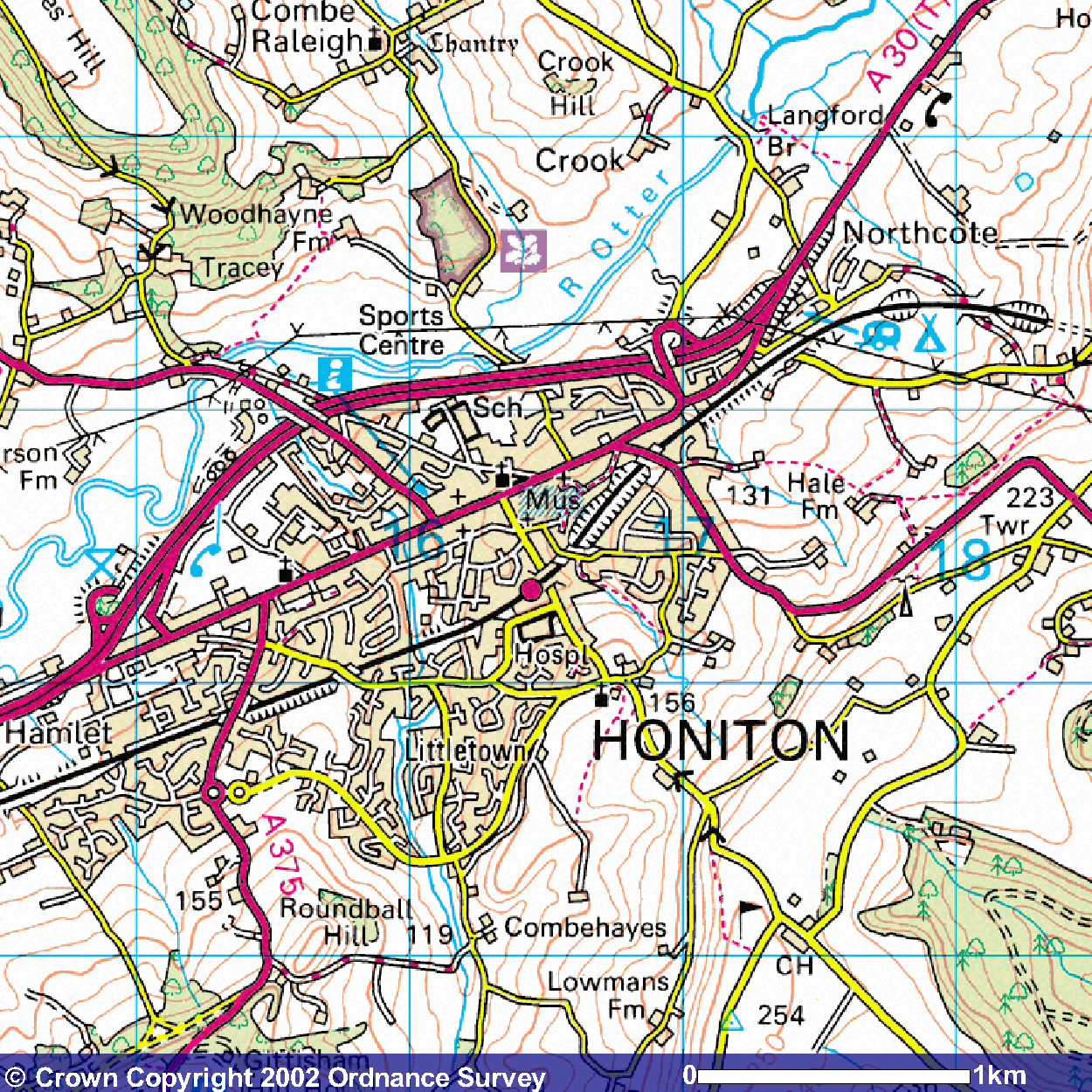
Image produced from the Ordnance Survey Get-a-map service and
reproduced with kind permission of Ordnance Survey
We spoke to the proprietor, telling him that I believed my grandfather had been an apprentice there - before 1900 - with a Mr Farley. This interested him greatly for he had bought the shop about 10 years earlier from a family who had taken it over around the time of the first world war but no one seemed to know who Farley had been. He took us to see where the main ovens were and I immediately visualised my grandfather as a 15 year old arriving each morning about 5 am working in front of those very ovens. The Bakery continued to train apprentices until only 2 or 3 years before our visit. The baker showed us some postcards of about 1904 showing New Street then looking rather 'up-market' and thus quite consistent with the high-class confections, cakes and cookies I knew Grandpa was so competent at baking. He eventually worked on early trans-Atlantic liners as a Confectioner-Chef, sailing between Bristol or Liverpool and Montreal. His great regret was declining an interview for a position as chief Baker at the largest hotel in Liverpool (then a very important city) around 1910, I believe. Instead, he decided to emigrate to Canada.
Once back home, I sought information on where the two Orphanage Schools would have been. The junior building was no longer there, being replaced before the war by a huge block of flats. The senior section on Haverstock Hill had been in an area known as Maitland Park. It existed there until the war in 1939 when it was evacuated to the country near Reading. The original building was built in 1847, enlarged in 1860 and then re-built in 1906. I saw a plaque on that now old building (recently an old people's home) which read: "Orphan's Working School, 1906". It had started life in 1758 at Hoxton, near the centre of the City. After the war, it became re-established on a new site near Reigate, Surrey and is still there today, serving both orphans and the children of service persnnel posted overseas. In 1996 it was in its 236th year. Its trustees typically include Royalty and the heads of British industry. Even in the 1890s, the Inspector writing back to the Exeter authorities felt he had to explain that the name 'Working' in the original name was an anomaly; it wasn't an industrial training school but one that gave a broadly-based liberal arts education. Young Joseph had lost a father to gain an education - to become at first a trained Baker and, later, the owner of a chain of Cinemas in Canada. It was a beginning... (See now Part Three for more on Joseph and his family.)
[Note: The foregoing was first compiled in 1979 and abridged in 1996. The earlier Censuses referred to were eventually examined. The findings and subsequent searchings into the origins of the Millman family which they led to are described in Part Two.]